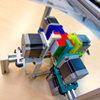Qualcomm Institute: Year in Review 2014
San Diego, December 30, 2014 -- It’s time to look back at the year that was. There were too many stories to do complete justice to the activities undertaken by and at the Qualcomm Institute, the UC San Diego division of the California Institute for Telecommunications and Information Technology (Calit2). So following is a cross-section of a dozen news releases and feature articles, stories about students and faculty, about brain science and robotics, awards and honors, and more. We picked one for each month of 2014. Herewith our Year in Review, counting backward. For more details, click on the headline to read the full article or news release. Enjoy!
|
DECEMBER
Recent Grads Build Puzzle-Solving Robot to Engage Students in STEM Fields
Two students used the Prototyping Lab in the Qualcomm institute to build the prototype for Ruku, a robot to solve the Rubik’s Cube. After graduating with undergraduate degrees in computer science and electrical engineering respectively, Daryl Stimm and William Mutterspaugh launched a Kickstarter crowdfunding appeal to launch a kit for middle and high school groups to use the robot as a tool of exciting both male and female students in robotics and other STEM areas.
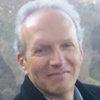 |
NOVEMBER
Cal-BRAIN Conference Brings Industry, Policy Stakeholders to UC San Diego
The Qualcomm Institute played host to a meeting of representatives from California-based companies, research institutes and patient advocacy group. The Center for Brain Activity Mapping (CBAM) at UC San Diego organized the two-day roundtable, which discussed priorities for funding under California’s Cal-BRAIN initiative, including a first allocation of $2 million earmarked in the state budget.
 |
OCTOBER
NIH Awards New National Center of Excellence for Mobile Sensor Data-to-Knowledge
The Qualcomm Institute’s Center for Wireless and Population Health Systems (CWPHS), led by School of Medicine professor Kevin Patrick, is participating with researchers from 10 other universities in a four-year, $10.8 million grant from NIH. The Mobile Sensor Data-to-Knowledge (MD2K) Center of Excellence will develop big-data solutions for reliable quantification of physical, biological, behavioral, social and environmental factors that contribute to health and disease risk.
 |
SEPTEMBER
UC San Diego Researchers Build First 500 GHz Photon Switch
Researchers in the institute’s Photonic Systems Group led by Prof. Stojan Radic have built the first 500 Gigahertz (GHz) photon switch, which is more than an order of magnitude faster than any previously published result to date. According to Radic, “that exceeds the speed of the fastest lightwave information channels in use today.” The findings were published in the journal Science.
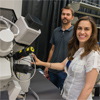 |
AUGUST
New Nano3 Microscope Will Allow High-Resolution Look Inside Cells
The institute’s Nano3 nanofabrication facility added an important new machine to its scientific arsenal, with the acquisition of an FEI Scios dual-beam microscope. The instrument includes a novel cryo capability, which makes it possible for cell biologists to see the structures of biological cells in higher resolution (at the temperature of liquid nitrogen), to better understand how they function as a molecular level.
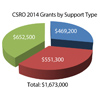 |
JULY
Qualcomm Institute Announces Seed Grants to Build Clusters in Brain, Medical and Robotics Research
The institute approved 35 new projects with grants up to $50,000 each as part of its Calit2 Strategic Research Opportunities (CSRO) program. At least 10 of the projects were directly related to brain-related research, and seven to other health-related topics. A handful of winning projects proposed work in the field of robotics and machine learning. The total $1,673,000 in support was divided between graduate fellowships, cash grants, and services or other in-kind support.
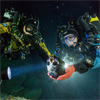 |
JUNE
3D Visualization Technique to Document Underwater Cave, Paleoamerican Remains
Researchers affiliated with the Qualcomm Institute’s Center of Interdisciplinary Science for Art, Architecture and Archaeology (CISA3), led by visiting scholar Dominique Rissolo, developed a three-dimensional model of the ancient Hoyo Negro cave on Mexico’s Yucatán Peninsula. CISA3’s Vid Petrovic used structure-from-motion (SfM), stitching together 2D photographs to create a 3D model of the cave.
 |
MAY
Innovative Network Appliance for Big Data
While most UCSD labs can now access a dedicated optical-fiber network connection 1,000 times faster than the shared Internet, they often don’t have the equipment needed to deal with all of that data. Enter the Flash I/O Network Appliance (FIONA), developed by Qualcomm Institute research scientist Tom DeFanti and SDSC’s Phil Papadopoulos. The low-cost, flash memory-based data server appliance can serve as a hub for Big Data in the lab, or as a workstation to analyze Big Data on large displays.
 |
APRIL
UC San Diego Research Scientist Honored with DRI Nevada Medal
At age 33, Qualcomm Institute research scientist Albert Yu-Min Lin became the youngest ever recipient of the DRI Nevada Medal, awarded annually by the Desert Research Institute, which cited his “pioneering work in a new era of digital exploration and science education through public engagement.” Lin, who is also a National Geographic Emerging Explorer, was feted at large events in Reno and Las Vegas, and spoke to schools and citizen groups. Lin is a triple graduate of UCSD with degrees in electrical engineering (BS ’04, MS ’06) and materials science (PhD ’08).
 |
MARCH
Capturing the Zeitgeist: Exploring Urban Trends through Selfies
Researchers in the Qualcomm Institute, including Lev Manovich and Mehrdad Yazdani, and the City University of New York, used advanced media tools to parse the selfie phenomenon. They produced a website, selfiecity.net,that allows viewers to visualize 3,200 Instagram selfies in order to compare patterns across New York, Bangkok, Berlin, Moscow and São Paulo.
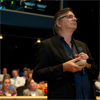 |
FEBRUARY
Sonic Arts R&D Licenses Audio Beamforming Technology to Comhear
The Qualcomm Institute and the company Comhear, Inc., announced a collaboration on audio conferencing technology, starting with the prototyping of a revolutionary new product designed to let users customize their listening environment based on an exclusive license for audio ‘beamforming’ technology (developed by a group led by QI Sonic Arts R&D director Peter Otto). The prototype for the new MyBeam Spatial Interactive Telepresence debuted at February’s Mobile World Congress in Barcelona, Spain.
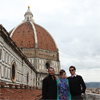 |
JANUARY
Students Look Back on Fall Field Expedition in Florence
When they weren’t traveling to give research presentations or participate in archaeological digs and engineering collaborations in southern Italy or Greece, six graduate students from the Qualcomm Institute’s Center of Interdisciplinary Science for Art, Architecture and Archaeology (CISA3) spent most of Fall 2013 quarter in Florence. Their projects stemmed from a Memorandum of Understanding giving CISA3 unprecedented access to capture L’Opera del Duomo structures with imaging and laser scanning – much as CISA3 had previously done with the Great Hall of the Palazzo Vecchio, also in Florence.
Media Contacts
Doug Ramsey, (858) 822-5825, dramsey@ucsd.edu
Tiffany Fox, (858) 246-0353, tfox@ucsd.edu
Related Links


